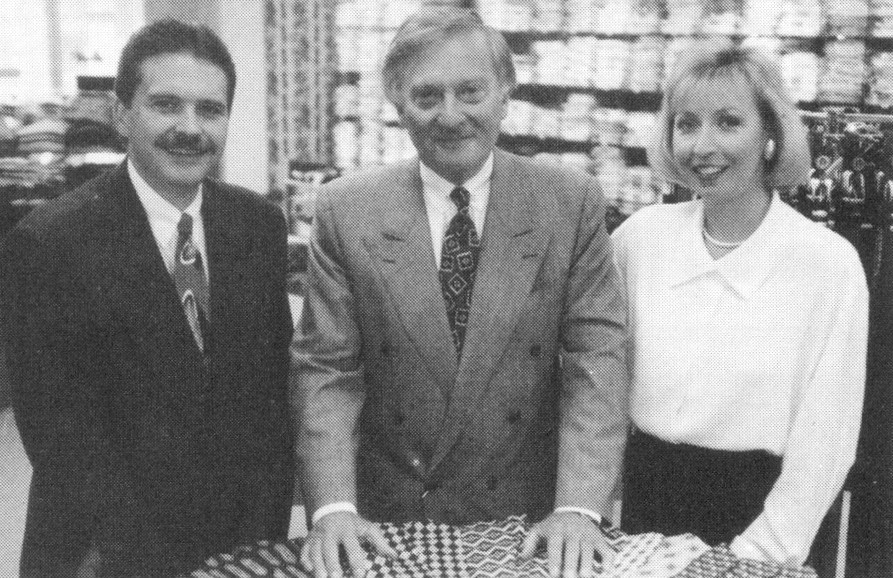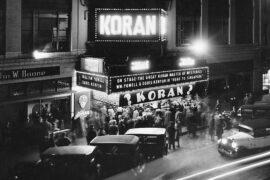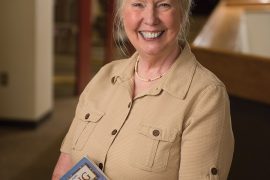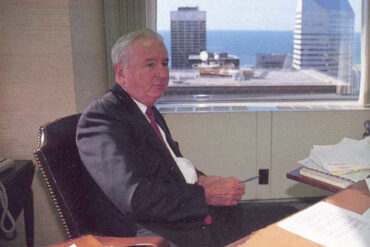The George H. Wright Co. has been tailor-made for downtown Huntington.
By Joseph Platania
HQ 19 | AUTUMN 1994
Trends in men’s fashions have changed almost as rapidly as women’s styles. Each decade has had its fashion staples from the gray flannel suit and Bermuda shorts of the 1950s, the leisure suit and designer jeans of the ’70s to the return of the double-breasted suit in the ’80s and ’90s. The George H. Wright Co., located at the corner of Fourth Avenue and Tenth Street, has seen men’s fashion trends come and go during the more than 70 years it has been a downtown store and continues to fit the needs of the community.
Thirty years ago, there were as many as 10 men’s stores in Huntington’s central business district. Some catered to younger men, especially college age, but most carried traditional styles for men of all ages. As the retail store with the most longevity, George H. Wright’s was the dean of the men’s wear trade in Huntington. Now it is the only remaining men’s store in downtown.
As a student at Marshall University, I was a part-time salesman at Wright’s during the 1964-65 Christmas shopping season. I worked on the main floor and in the downstairs store, where men’s furnishings and accessories such as shirts, ties, socks, sweaters and cuff links were sold. I didn’t venture on the second floor where the suit department was located. On that floor were rows and rows of tailored suits, sport coats, top coats and pants. This was the domain of the fulltime salesmen who worked on commission. Sales of stock in this department carried the store both financially and in its reputation.
George H. Wright, founder and president of the company that bears his name, was a native of Falmouth, Kentucky. He got his first job in a clothing store in his hometown because “he liked to dress well,” according to a Huntington newspaper story.
In 1906, Wright moved to Huntington because a friend had told him it was a “thriving and energetic town,” according to another newspaper article. He was first employed by the former Biern and Friedman Co., then located at Fourth Avenue and Ninth Street. Later, he was employed by Sam and Dave Gideon when their clothing store was at 949 Third Avenue.
When George H. Wright arrived in Huntington, the city “had many clothing and tailoring establishments such as Broh Brothers, Gideon’s, Ziegler’s, J.H. Cammack, Northcott and Buffington, H.H. Kelly, Paul Dober and others where men’s suits and topcoats were sold or made to order,” according to a local history.
In 1912, George H. Wright went out on his own and opened a men’s store in the Adelphi Hotel, then located on the northwest corner of Fifth Avenue and Ninth Street, in partnership with Claude Walker. Later that decade, the firm of Wright, Walker and Co. had a store at 314 Ninth Street, states the 1917 Huntington city directory.
According to Wright’s daughter, Mrs. T. H. Crickard, by the early 1920s her father had his first store, The George H. Wright Co., in the 800 block of Fourth Avenue, where Chili Willi’s Mexican Cantina now is located.
Mrs. Crickard says that in the late ’20s her father opened his store at its present location in the Frederick Hotel building. “At that time, the store consisted of the main floor and a balcony on the Tenth Street side,” says Mrs. Crickard. She adds that the balcony was the site of the store’s tailoring shop.
Mrs. Crickard says that during the 1920s her father also had a small store in the Prichard Hotel, on the southwest corner of Sixth Avenue and Ninth Street.
The location of the George H. Wright Co. on the first floor of the Frederick, the city’s premier hotel, was an advantageous site. The corner of Fourth Avenue and Tenth Street then, as today, was “the main corner of town.”
The Frederick Hotel, which opened to guests in 1906, was designed by Huntington architect James B. Stewart who also designed the Carnegie Library at Fifth Avenue and Ninth Street in 1904. According to a contemporary newspaper account, the 200-room Frederick was designed to be “the largest and finest hotel in the state.”
The Frederick soon earned the reputation as the best hotel between Pittsburgh and Cincinnati, and it was the hotel of choice of traveling salesmen.
During the Frederick’s early years, there was a large drugstore with fountain service for its customers located on the first floor, where Wright’s is located, with its entrance on the corner.
Mrs. Crickard recalls that there was a bank on the first floor of the Frederick before her father opened his store. She believes that the bank’s fireproof safe still is on the premises.

In the 1920s, a well-dressed man could find the latest in fashion at the George H. Wright Co. – everything from long, fur-trimmed topcoats with contrasting striped pants to Panama hats, suits and ready-made Arrow shirts with collars attached as well as ties and shoes.
In 1924 and again in 1925, George H. Wright was voted the “Best-Dressed Man in America” by the National Association of Retail Clothiers, Furnishers and Manufacturers. Mrs. Crickard recalls that one year her father defeated the famous movie actor Adolph Menjou for the title, which was awarded in Chicago, Illinois. Wright’s photograph appeared in newspapers all over the United States and in London and Paris, according to a Huntington newspaper story.
The 1937 Ohio River flood was a shared experience for downtown merchants. In a 1987 newspaper interview, Mrs. Crickard remembered being in a rowboat downtown and ducking her head to miss a traffic light. Her father had stashed his store’s merchandise on the top floor of the Frederick, said Mrs. Crickard, adding that the Wright family stayed at the Prichard Hotel until the flood water receded.
In the 1987 newspaper story, Mrs. Crickard remembered that after World War II, “men in Huntington were still observing Straw Hat Day on May 15, trading in their felt business tops for stiff-crowned ‘boaters.”‘ The article adds that Huntington was then known as the “We Will City.”
In 1945-46, Wright’s was enlarged to include a full second floor.
Through the years, until the Frederick closed, many of the hotel’s guests patronized Wright’s, which had an entrance for the hotel lobby.
During his long career as a downtown merchant, George H. Wright was active in the men’s wear industry and was president of the Huntington Retail Merchants Association for numerous terms. He also served at least two terms as president of the Retailers Association and once was a member of the board of directors of the National Association of Retail Clothiers and Furnishers.
George H. Wright continued to come into his store on a regular basis until his death at age 80 on Aug. 27, 1966. The Huntington newspaper wrote that “through his meticulous attention to detail (Wright) had consistently brought the latest and best in men’s wear to the appreciative men of Huntington.”
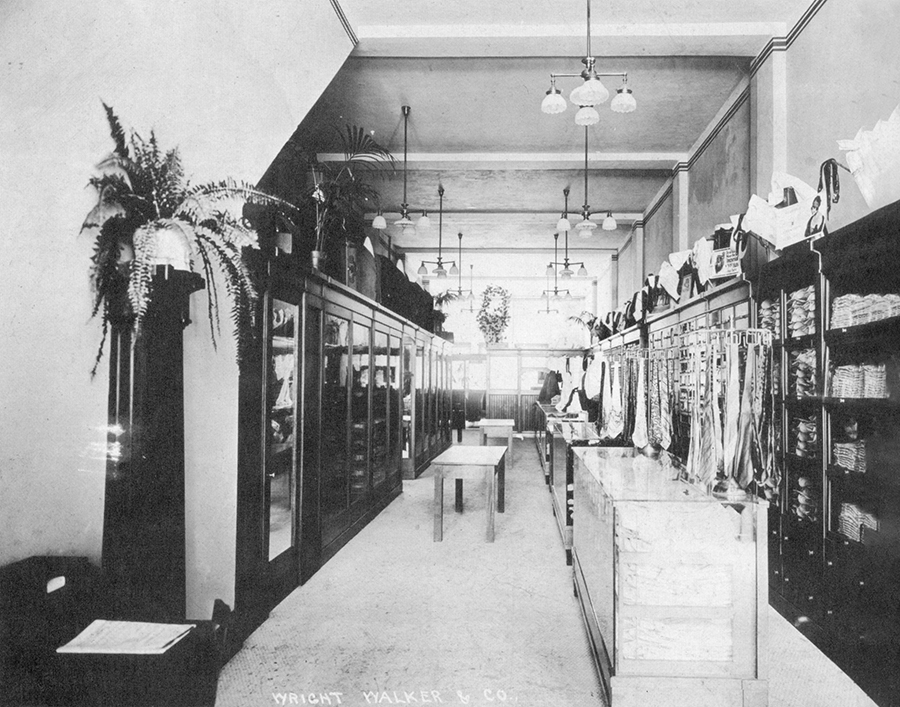
Following his father’s death, George H. Wright Jr. took over as president of the company. Fifteen months later, George H. Wright Jr. died in an automobile accident in November 1967. After his death, his widow and his sister assumed the ownership and operation of the store.
In 1974, Mrs. George H. Wright Jr. and Mrs. T.H. Crickard sold the business to Mr. and Mrs. Charles Jambe.
Charles Jambe, president of the George H. Wright Co., was born in Huntington. After he graduated from Marshall College in 1951, he entered military service. He married in 1957 and he and his wife moved to New York, where he worked in sales for a tobacco company. In the early 1970s, the Jambes wanted to return to Huntington and heard that the George H. Wright Co. was for sale. They made an offer that was accepted and took over the store’s operation in 1974.
During 1975-76, after the purchase of the old Hanover Shoes location next door on Fourth Avenue, Wright’s expanded and began carrying· women’s clothing such as suits, sportswear and accessories. Jambe says that the store now has approximately 8,000 square feet of floor space on three floors, although the former downstairs store now is used for the alteration department and for storage.
Jambe says that most of Wright’s customers come from within a 30-mile radius of Huntington, although some come from as far as Gallipolis, Ohio, and Hurricane in Putnam County. He adds that a few regulars also come from Charleston.
Jambe emphasizes that the majority of Wright’s customers are Huntingtonians, and some have been regulars for 30, 40 and even 50 years.
During the early 1980s, Wright’s expanded to three locations – the downtown store, one in Charleston, and one at the Huntington Mall. However, this didn’t work out and now there is only the main store.
Jambe explains that 50 to 55 percent of their sales are form tailored clothing such as suits, sport coats, pants and topcoats with the rest from men’s and women’s sportswear, men’s furnishings and accessories. He comments that Wright’s is “the only place within 100 miles a customer can buy a felt hat.”

The store carries name brand suits such as Hickey-Freeman, Hart Shaffner and Marx, Dior, Burberry, Palm Beach and other brands. Suit prices range from $220 up to $1000, says Jambe, with the average selling price of $375. He adds that ties can go as high as $75 apiece with an average selling price of $45.
Wright’s is best known for tailored clothing and this requires an expert tailoring and alterations department. Jambe says that one woman has been doing their alterations for 30 years and another for 18.
There also is a shoe department on the main floor that carries several name brands of top quality shoes.
Jambe says Wright’s employs from eight to 12 people with more during the Christmas shopping season.
He explains that Wright’s “specializes in upscale, upper end customers who demand service and quality merchandise.”
Wright’s also offers custom-made shirts tailored in New Jersey and custom-made suits tailored in Rochester, New York and Chicago.
When asked if any famous customers have ever come through the doors at Wright’s, Jambe recalls that Sen. George McGovern bought a sports coat during a visit to Huntington. And Paul Newman did some shopping in the store when he was in town to do some research for a movie role back in the mid-1960s. Jambe adds that an internationally-known violinist who was performing at the Marshall Artists Series at the KeithAlbee bought some clothing at Wright’s.
As for the future of Huntington’s central business district, Jambe remarks that now, and for the foreseeable future, people are coming downtown for a specific purpose – to shop at Wright’s or Stone and Thomas or to eat at Bailey’s Cafeteria and not, as in the past, to spend the day shopping in retail stores.
After some 70 years in the same location, the George H. Wright Co. is a downtown landmark. During this time, Wright’s has consistently maintained high standards in the store’s exterior and interior appearance and in the quality of merchandise it has offered for sale to its customers.
This might be expected in a clothing establishment whose founder was twice voted the “Best-Dressed Man in America.”

